Bringing hope to former opium-growing Laos communities
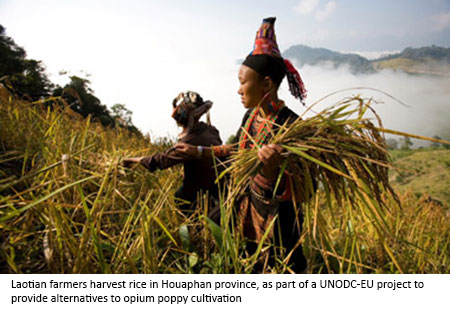
Houphan (Lao PDR), 22 October 2013 - Since being declared virtually opium free in 2006, the Lao People's Democratic Republic (PDR) has seen opium poppy cultivation rise to 6,800 hectares (ha) in 2012, a 66 per cent increase from 2011 - and nearly back to 2004 cultivation levels. The bulk of Lao PDR's opium cultivation - which largely supplies local users - occurs in four northern provinces near the country's borders with Myanmar, China and Viet Nam: Phongsali, Louang Namtha, Houaphan and Lounangphrabang, according to the UNODC report,
South-East Asia Opium Survery 2012 - Lao PDR, Myanmar.
The absence of alternative sources of income and licit livelihoods, poor access to markets and schools, and the high price of opium make its cultivation attractive to farmers. The Lao Government estimates that in 2012 up to 38,400 households - many in remote communities - were associated with the cultivation of opium poppy, a significant increase from 2011 figures (8,300 to 20,000 households).
Begun in early 2011, a four-year joint UNODC-European Union (EU) alternative development effort aims to support Lao Government efforts to ensure the sustainable elimination of opium poppy cultivation in 35 former opium poppy growing villages in Houaphan province's Xamtai District.
Through sustained, targeted interventions to increase food security, build infrastructure, promote licit crop production and support small farmer enterprises, the UNODC-EU alternative development project is making a real difference for the people and communities of Houphan.
Providing micro credit is a key part of UNODC-EU support to small farmers.
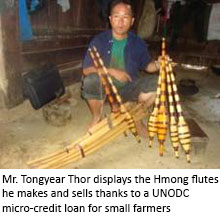 Mr. Tongyear Thor, was one of the poorest farmers in Naphadeng village, Xamtai district, when the UNODC-EU project began. Then he borrowed 500,000 kips (USD 63) from the project's village saving and credit group (VSCG) - a micro credit fund - and began making and selling Hmong flutes.
Mr. Tongyear Thor, was one of the poorest farmers in Naphadeng village, Xamtai district, when the UNODC-EU project began. Then he borrowed 500,000 kips (USD 63) from the project's village saving and credit group (VSCG) - a micro credit fund - and began making and selling Hmong flutes.
Since then, Mr. Thor's business has steadily grown. His family can eat rice all year and raises livestock. In 2012, he borrowed 1.5 million kips (USD 190) to continue making Hmong flutes, and expects a profit of 1.7 million kips (USD 216).
"Before the UNODC loan, I struggled to provide for my eight children," Mr. Thor said. "Now, thanks to my flute business, my children go to school. I can buy medicine, food, and clothing for my family. We own two motorcycles and a rice mill - and even have solar electricity in our house!"
Strengthening local communities
A key element of UNODC's community centered alternative development strategy is strengthening local authorities. This helps communities sustain opium elimination, and reduces the risk of organised criminal networks targeting vulnerable communities.
In Korlou village, Mr. Seetha Keophomisay, the village chief, could not afford to send his children to school or grow enough rice to feed his family. Disease constantly killed his livestock.
After UNODC and the EU established a VSCG in his village in June 2011, Mr. Keophomisay used its micro-credit facility to borrow 5 million kip (USD 634) to buy and raise cows, pigs, chicken and ducks. In 2012, he earned 6.23 million kip (USD 790) from livestock sales alone.
He also attended farming and livestock-raising training under the project, which sent him to observe and study vegetable-growing techniques in Oudomxai province greenhouses. Upon his return, he joined a project initiative to grow rainy season vegetables.
"We grew so many vegetables," said Mr. Keophomisay. "More than enough to feed my family through the rainy season - I was even able to sell an additional 100 kg of Chinese cabbage!"
Mr. Keophomisay now manages the Korlou VSCG, which has grown from 32 to 52 members (including 23 women), and has 78.8 million kip (USD 9,892) in the project fund - over 18.8 million kip (USD 2,384) of it interest earned from member savings.
Promoting licit crop production
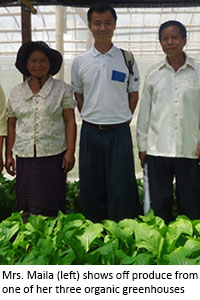 Mrs. Maila, a 42-year-old greenhouse and organic vegetable grower from Meaungkwuan village, in Houaphan Province, joined the UNODC-EU project in 2011. Her two hectares of land hold a paddy field, fish pond, and three greenhouses filled with organic vegetables, coriander, dill, green mustard, and lettuce. An avid learner, Mr. Maila has traveled to Thailand to study organic farming. She also gives back to her community, and eagerly shares what she's learned with other farmers.
Mrs. Maila, a 42-year-old greenhouse and organic vegetable grower from Meaungkwuan village, in Houaphan Province, joined the UNODC-EU project in 2011. Her two hectares of land hold a paddy field, fish pond, and three greenhouses filled with organic vegetables, coriander, dill, green mustard, and lettuce. An avid learner, Mr. Maila has traveled to Thailand to study organic farming. She also gives back to her community, and eagerly shares what she's learned with other farmers.
Since joining the project, Mrs. Maila has seen her annual income increase from about 3-4 million kip (about USD 385-514) to 8 million kip (about USD 1,000) in 2013 - from greenhouse vegetable production alone.
From opium addict to village head
The UNODC-EU project also works to raise awareness of opium's dangers. This has had a positive impact on opium users, their families and communities across Laos.
In Phalom village, Xamtai district, Mr. Chue Va was an opium addict whose habit cost him 25,000 kips daily (USD 3.17) - and left his seven-person family with not enough food to eat.
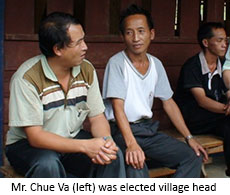 A UNODC-EU project team visited Mr. Va's village in July 2011 to raise awareness about opium's dangers. It organized a 15-day detoxification session for opium addicts, which Mr. Va successfully completed. Afterwards, project staff gave him conselling and monitoring.
A UNODC-EU project team visited Mr. Va's village in July 2011 to raise awareness about opium's dangers. It organized a 15-day detoxification session for opium addicts, which Mr. Va successfully completed. Afterwards, project staff gave him conselling and monitoring.
No longer smoking opium and in significantly better health, Mr. Va now works regularly and can support his family, who no longer live below the poverty line and own a motorcycle.
People have noted his progress: On 8 February 2012, his fellow villagers elected Mr. Va village head, a position he holds to this day.
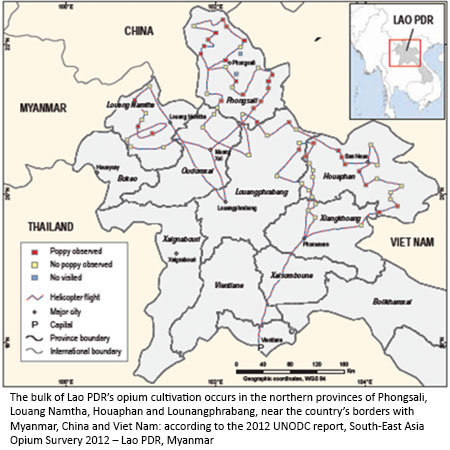
Background:
Funded by the European Union, Germany, Luxembourg, the UNODC alternative livelihoods programmes that operate in Laos include the
Balanced approach to opium elimination in Lao PDR programme; the
Increasing food security, promoting licit crop production and small farmer enterprise development in Houaphan and Oudomxay provinces; and the
Phongsaly Alternative Livelihood and Food Security (PALAFS).

 Mr. Tongyear Thor, was one of the poorest farmers in Naphadeng village, Xamtai district, when the UNODC-EU project began. Then he borrowed 500,000 kips (USD 63) from the project's village saving and credit group (VSCG) - a micro credit fund - and began making and selling Hmong flutes.
Mr. Tongyear Thor, was one of the poorest farmers in Naphadeng village, Xamtai district, when the UNODC-EU project began. Then he borrowed 500,000 kips (USD 63) from the project's village saving and credit group (VSCG) - a micro credit fund - and began making and selling Hmong flutes.
 Mrs. Maila, a 42-year-old greenhouse and organic vegetable grower from Meaungkwuan village, in Houaphan Province, joined the UNODC-EU project in 2011. Her two hectares of land hold a paddy field, fish pond, and three greenhouses filled with organic vegetables, coriander, dill, green mustard, and lettuce. An avid learner, Mr. Maila has traveled to Thailand to study organic farming. She also gives back to her community, and eagerly shares what she's learned with other farmers.
Mrs. Maila, a 42-year-old greenhouse and organic vegetable grower from Meaungkwuan village, in Houaphan Province, joined the UNODC-EU project in 2011. Her two hectares of land hold a paddy field, fish pond, and three greenhouses filled with organic vegetables, coriander, dill, green mustard, and lettuce. An avid learner, Mr. Maila has traveled to Thailand to study organic farming. She also gives back to her community, and eagerly shares what she's learned with other farmers.
 A UNODC-EU project team visited Mr. Va's village in July 2011 to raise awareness about opium's dangers. It organized a 15-day detoxification session for opium addicts, which Mr. Va successfully completed. Afterwards, project staff gave him conselling and monitoring.
A UNODC-EU project team visited Mr. Va's village in July 2011 to raise awareness about opium's dangers. It organized a 15-day detoxification session for opium addicts, which Mr. Va successfully completed. Afterwards, project staff gave him conselling and monitoring.
